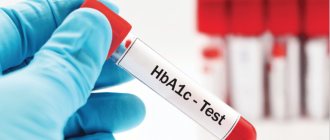Detailed description of the study
General blood test extended with leukocyte formula and reticulocytes in the Hemotest Laboratory includes determination of hemoglobin concentration, number of red blood cells, platelets, leukocytes, hematocrit value, average volume of red blood cells (MCH), average hemoglobin content in a red blood cell (MCH), average hemoglobin concentration in a red blood cell (MCHC), RDW-SD, RDW-CV, normoblasts, normoblasts %, delta hemoglobin, mean platelet volume, platelet volume distribution width, thrombocrit, immature granulocytes, immature granulocytes %, color index, neutrophils %, neutrophils, eosinophils %, eosinophils, basophils%, basophils, monocytes%, monocytes, lymphocytes%, lymphocytes, reticulocytes%, reticulocytes, hemoglobin content in reticulocytes, fraction of immature reticulocytes, corrected reticulocyte count, reticulocyte production index.
Venous blood is considered the best material for laboratory research:
- To ensure the quality of the test result, it is necessary to donate venous blood (unless the child has special indications for taking capillary blood). When blood is taken from a finger, the blood cells are deformed, and some of the red blood cells are destroyed, forming microscopic clots in the test tubes. In this case, it is impossible to conduct research; in this case, repeated collection of biomaterial is required.
- In venous blood, blood cells are not destroyed, microscopic clots are formed much less frequently. That is why capillary blood is used only in children in isolated cases.
- Thanks to modern technologies, the procedure for collecting venous blood is painless and safe even for small children, since completely closed disposable BD vacuum systems are used, which eliminate infection and meet all international standards.
- Taking blood from a vein takes a few seconds.
A general blood test is a laboratory test aimed at determining the number of different blood cells, their parameters (size, etc.) and indicators reflecting their relationship and functioning.
The main indicators that are included in the table of results of a general blood test:
Hemoglobin (Hb, Hemoglobin)
Hemoglobin is a respiratory pigment in the blood, which is found in red blood cells and is involved in the transport of oxygen and carbon dioxide. The hemoglobin content in the blood of men is slightly higher than that of women. In children of the first year of life, a physiological decrease in hemoglobin concentration may be observed. A pathological decrease in blood hemoglobin (anemia) may be a consequence of increased losses during various types of bleeding, the result of accelerated destruction of red blood cells, and impaired formation of red blood cells. Anemia can be either an independent disease or a symptom of a chronic disease.
Hematocrit (Ht, Hematocrit)
Hematocrit is the percentage of all formed elements (quantitatively, mainly red blood cells) of the total blood volume.
Red blood cells (RBC, Red Blood Cells)
Erythrocytes (red blood cells) are highly specialized anucleate blood cells filled with a respiratory pigment - the iron-containing protein hemoglobin. The main function of red blood cells is oxygen transport. They are formed in the red bone marrow. The formation of red blood cells is stimulated by erythropoietin, synthesized in the kidneys (in increased quantities during hypoxia). For normal hemoglobin synthesis and the formation of red blood cells, vitamin B12 and folic acid are necessary, and there must be a sufficient supply of iron. Normally, the lifespan of an erythrocyte in the bloodstream is 120 days. Red blood cells are destroyed in the spleen and reticuloendothelial system. Determination of the number of red blood cells, in combination with the study of hemoglobin content, assessment of hematocrit and characteristics of red blood cells (erythrocyte indices) is used in the differential diagnosis of anemia.
MCV (Mean Cell volume, average volume of red blood cells)
A calculated indicator reflecting the average volume of red blood cells, which is used in the diagnosis of anemia (microcytic, macrocytic, normocytic). With pronounced anisocytosis (the presence of cells with different volumes), as well as the presence of a large number of red blood cells with an altered shape, this indicator is of limited value.
RDW (Red cell Distribution Width, distribution of red blood cells by size)
A calculated indicator reflecting the degree of anisocytosis (heterogeneity of red blood cells by volume). Used for differential diagnosis and monitoring of treatment of anemia of various origins.
MCH (Mean Cell Hemoglobin, average hemoglobin content in red blood cells)
A calculated indicator reflecting the average hemoglobin content in 1 cell (erythrocyte). Used, like MCV, for the differential diagnosis of anemia.
MCHC (Mean Cell Hemoglobin Concentration, mean hemoglobin concentration in red blood cells)
Concentration index is a calculated indicator reflecting the average concentration of hemoglobin in red blood cells. A sensitive indicator of changes in hemoglobin formation - in particular, in iron deficiency anemia, thalassemia, and some hemoglobinopathies.
Platelets (PLT, Platelets)
Platelets are anucleate cells that, in their granules and on the surface, contain many active substances and some coagulation factors that enter the blood when platelets are activated. Platelets are capable of aggregation (connecting with each other) and adhesion (sticking to a damaged vascular wall), which allows them to form a temporary clot and stop bleeding in small vessels. Formed in red bone marrow. The lifespan of a platelet in the bloodstream is 7–10 days. A decrease in platelet count can occur either due to increased platelet consumption or due to insufficient production. Clinical manifestations (increased bleeding, up to life-threatening conditions) occur when the platelet concentration is less than 50*103 cells/μl.
Leukocytes (WBC, White Blood Cells)
Leukocytes (white blood cells) are nucleated blood cells involved in the recognition and neutralization of foreign elements, the elimination of altered and decaying cells of one’s own body, and various immune and inflammatory reactions. This is the basis of the body's antimicrobial defense. They are formed in the red bone marrow and organs of the lymphatic system. Blood consists of cells (formed elements) and a liquid part - plasma. These cells—red blood cells, white blood cells, and platelets—are formed and mature in the bone marrow and must be released into the systemic circulation as needed.
Different types of leukocytes have slightly different functions, however, they are capable of coordinated interactions by “communicating” using certain substances - cytokines. If the analyzer detects atypical forms of cells, or significant deviations from reference values are detected, then the leukocyte formula is supplemented by a microscopic examination of a blood smear, which makes it possible to diagnose certain diseases, such as, for example, infectious mononucleosis, determine the severity of the infectious process, describe the type of atypical cells identified during leukemia.
Neutrophils , the most numerous of the white blood cells, are the first to fight infection and are the first to appear at the site of tissue damage. Neutrophils have a nucleus divided into several segments, which is why they are also called segmented neutrophils or polymorphonuclear leukocytes. These names, however, refer only to mature neutrophils. Maturing forms (young, rod-nucleated) contain a solid core.
At the site of infection, neutrophils surround bacteria and eliminate them by phagocytosis.
Lymphocytes are one of the most important parts of the immune system; they are of great importance in destroying viruses and fighting chronic infection. There are two types of lymphocytes - T and B (the leukocyte formula does not count the types of lymphocytes separately). B-lymphocytes produce antibodies - special proteins that bind to foreign proteins (antigens) found on the surface of viruses, bacteria, fungi, and protozoa. Surrounded by antibodies, cells containing antigens are accessible to neutrophils and monocytes, which kill them. T lymphocytes are able to destroy infected cells and prevent the spread of infection. They also recognize and destroy cancer cells.
There are not very many monocytes in the body, however, they perform an extremely important function. After a short circulation in the bloodstream (20-40 hours), they move into tissues, where they turn into macrophages. Macrophages are capable of destroying cells, just like neutrophils, and keeping foreign proteins on their surface, to which lymphocytes react. They play a role in maintaining inflammation in some chronic inflammatory diseases such as rheumatoid arthritis.
of eosinophils in the blood; they are also capable of phagocytosis, however, they mainly play a different role - they fight parasites, and also take an active part in allergic reactions.
There are also few basophils in the blood. They travel to tissues where they become mast cells. When they are activated, they release histamine, which causes allergy symptoms (itching, burning, redness).
Reticulocytes are young red blood cells (erythrocytes). They are formed in the bone marrow when stem cells differentiate and divide to become adult red blood cells through the reticulocyte stage, gradually losing their nucleus and decreasing in size.
Newborns have more reticulocytes than adults.
Most red blood cells are already fully mature when they leave the bone marrow and enter the bloodstream, but 0.5-2% of those circulating in the blood are reticulocytes, which turn into adult red blood cells within two days. This test shows the number and percentage of reticulocytes in the blood and reveals the adequacy of red blood cell production by the bone marrow and the degree of its activity.
Why is a detailed blood test necessary?
A general blood test allows you to determine the level of only some parameters. If, based on its results, the doctor detects the presence of pathological deviations from the norm, then a detailed blood test is performed to make an accurate diagnosis. Its other name is an extended blood test.
A detailed blood test allows you to most effectively analyze the condition of organs, body systems, as well as the patient’s well-being. Based on the indicators of an extended blood test, it is possible to detect the current inflammatory process and monitor the treatment process. The final diagnosis is made in combination with a clinical examination by a doctor and other tests.
Blood test for hemoglobin
Hemoglobin is a complex protein found in red blood cells. It consists of two parts: the protein globin and the iron compound heme. Iron atoms are red, which determines the color of blood. Hemoglobin takes part in the transport of oxygen and carbon dioxide between the lungs and the cells of internal organs, and also maintains the pH of the blood.
Lack of hemoglobin can cause oxygen deficiency for cells, which is detrimental to their life. It is for this reason that blood test results for hemoglobin are so important. The normal level of hemoglobin in the blood for men is 130-160 g/l, for women – 120-140 g/l. In children under one year and under six years old – 90-140 g/l and 105-150 g/l, respectively.
Low hemoglobin levels may indicate anemia. Increased hemoglobin can be a symptom of erythrocytosis (a disease that is accompanied by an increase in the number of red blood cells in the blood), cardiopulmonary failure, congenital heart defects, intestinal obstruction, and blood thickening. High levels of glycated hemoglobin are observed in diabetes mellitus and iron deficiency.
What does MCH mean?
Having recorded picograms of MCH, it is possible to determine the content of average hemoglobin in the blood structure. Violation of permissible limits consistently leads to transformation in bone marrow cells and red blood cells. To understand what exactly provokes a change in blood composition, it is worth finding out what MSI is.
Analysis - records the hemoglobin content in the red blood cell. The final figures are calculated using the formula, dividing the total hemoglobin by the resulting volume of red blood cells.
Within acceptable limits, data is limited to 24 - 35 picograms. For children of different ages, the values may differ.
A discrepancy in MCH values occurs under the influence of various factors, which has an impact on the average blood CP value. It is the result obtained that is the basis for diagnosing anemia.
Indications for analysis
The study of material for MCH and MCHC is usually not carried out to determine only this indicator. The significance is paid attention to when undergoing laboratory blood tests, along with others.
Doctors often prescribe a complete blood count to check for MSI in patients with signs of anemia, especially in the acute period. The situation is quite serious, since loss of strength and lack of vital energy have a negative effect on the usual way of life, physical and psycho-emotional health. Sometimes it is enough to make some adjustments to the way of life, change gastronomic habits in order to positively affect the functional processes in the body.








